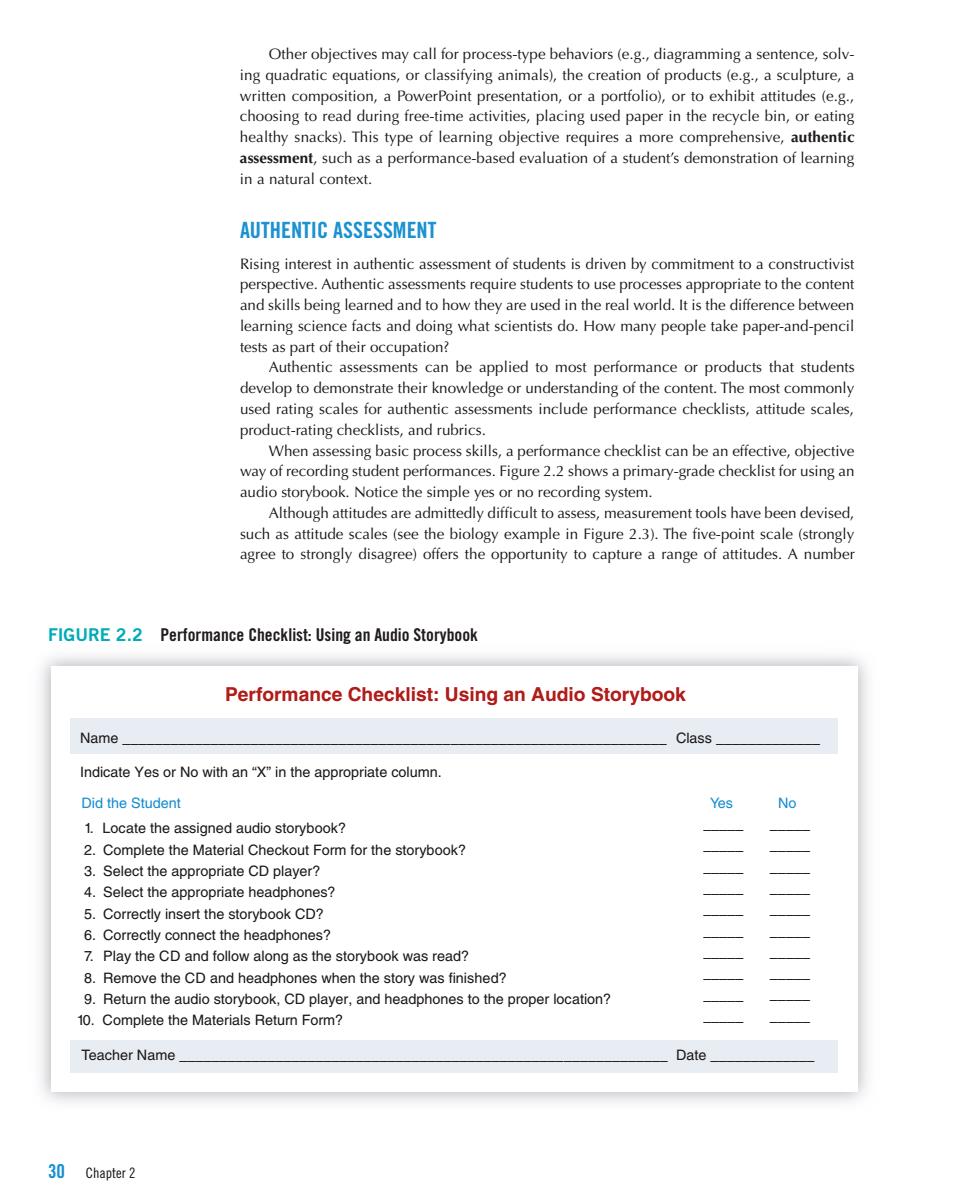正在加载图片...

Oher objectives may cll for process-type behaviors diagra q sifying animals),the ritten comp a Pow nt presen or a ng to ring free-time activi placing use ed pape In t ealthy snacks).This type of le he recycle arning obje comprenen ve.aumner such as a performance-based evaluation of a student's demonstration of learning in a natural context. AUTHENTIC ASSESSMENT Rising interest in authentic assessment of students is driven by commitment to a constructivist perspective.Authentic assessments require students to use processes appropriate to the content and skills being learned and to how they are used in the real world.It is the difference between learning science facts and doing what scientists do.How many people take paper-and-pencil tests as part of their occupation? Authentic assessments can be applied to most performance or products that students develop to demonstrate their knowledge or understanding of the content.The most commonly used rating scales for authentic assessments include performance checklists,attitude scales, roduct-rating checklists,and rubrics. essing basic t ss skills.a performance checklist can be an effective.obiective way of recording student performances.Figu ure 2.2 shows a priman grade checklist for us sing an audio storybook.Notice the simple yes or no recording syst adm ittedly difficult to ment tools have been devised, uch as ude scales (s e in Figure 2.3).Th rongly disa the capture a range tudes.A FIGURE 2.2 Performance Checklist:Using an Audio Storybook Performance Checklist:Using an Audio Storybook Name Clas Indicate Yes or No with anXin the appropriate column Did the Student Yes No 1 Locate the assianed audio storvbook? 2.Complete the Material Checkout Form for the storybook? iate CD player? 4 Select the Correctly insert th Correctly connect the he Play the CD a and follow along as the storybook was read 8.Remove the CD and headphones when the story was finished? 9.Return the audio storybook,CD player,and headphones to the proper location? 10.Complete the Materials Retum Form? Teacher Name Date 30 Chapter 230 Chapter 2 Other objectives may call for process-type behaviors (e.g., diagramming a sentence, solving quadratic equations, or classifying animals), the creation of products (e.g., a sculpture, a written composition, a PowerPoint presentation, or a portfolio), or to exhibit attitudes (e.g., choosing to read during free-time activities, placing used paper in the recycle bin, or eating healthy snacks). This type of learning objective requires a more comprehensive, authentic assessment, such as a performance-based evaluation of a student’s demonstration of learning in a natural context. Authentic Assessment Rising interest in authentic assessment of students is driven by commitment to a constructivist perspective. Authentic assessments require students to use processes appropriate to the content and skills being learned and to how they are used in the real world. It is the difference between learning science facts and doing what scientists do. How many people take paper-and-pencil tests as part of their occupation? Authentic assessments can be applied to most performance or products that students develop to demonstrate their knowledge or understanding of the content. The most commonly used rating scales for authentic assessments include performance checklists, attitude scales, product-rating checklists, and rubrics. When assessing basic process skills, a performance checklist can be an effective, objective way of recording student performances. Figure 2.2 shows a primary-grade checklist for using an audio storybook. Notice the simple yes or no recording system. Although attitudes are admittedly difficult to assess, measurement tools have been devised, such as attitude scales (see the biology example in Figure 2.3). The five-point scale (strongly agree to strongly disagree) offers the opportunity to capture a range of attitudes. A number Performance Checklist: Using an Audio Storybook Did the Student Yes No 1. Locate the assigned audio storybook? 2. Complete the Material Checkout Form for the storybook? 3. Select the appropriate CD player? 4. Select the appropriate headphones? 5. Correctly insert the storybook CD? 6. Correctly connect the headphones? 7. Play the CD and follow along as the storybook was read? 8. Remove the CD and headphones when the story was finished? 9. Return the audio storybook, CD player, and headphones to the proper location? 10. Complete the Materials Return Form? _____ _____ _____ _____ _____ _____ _____ _____ _____ _____ _____ _____ _____ _____ _____ _____ _____ _____ _____ _____ Teacher Name _____________________________________________________________ Date _____________ Name ____________________________________________________________________ Class _____________ Indicate Yes or No with an “X” in the appropriate column. Figure 2.2 Performance Checklist: Using an Audio Storybook M02_SMAL4150_01_SE_C02.indd 30 2/7/14 8:37 AM